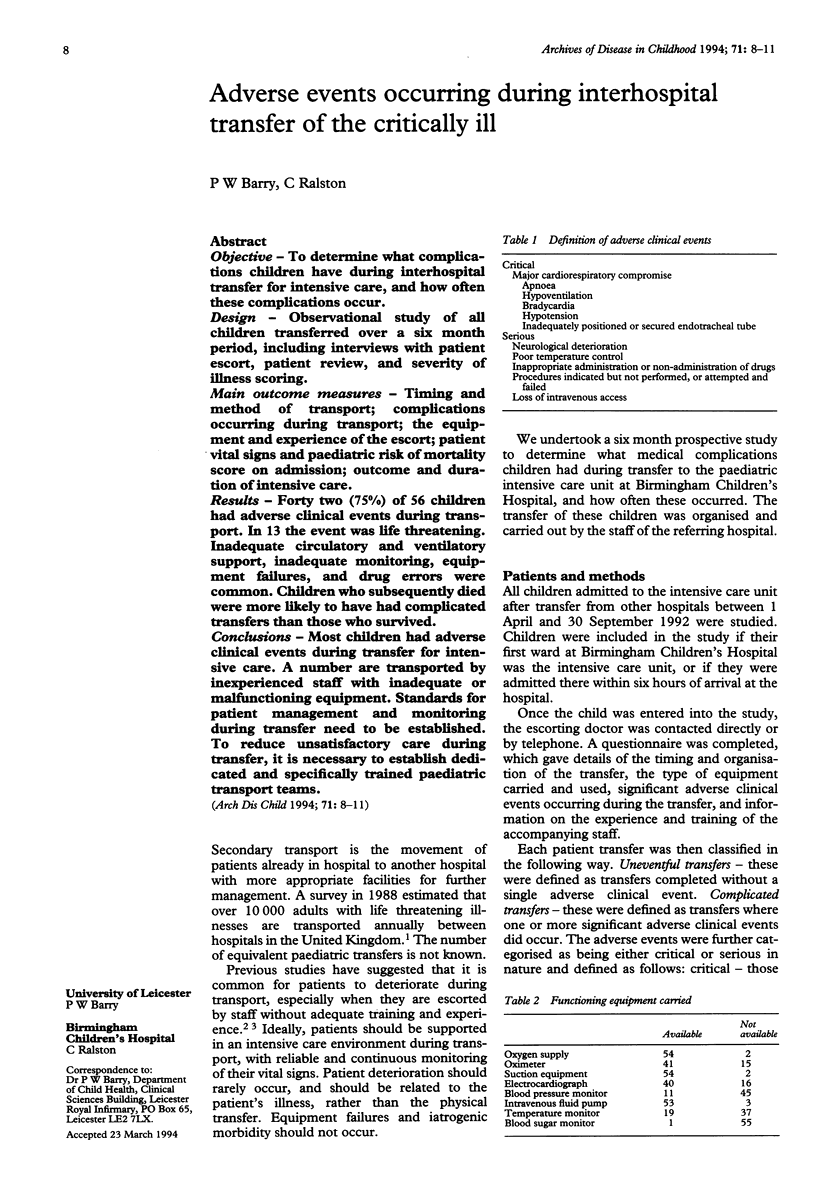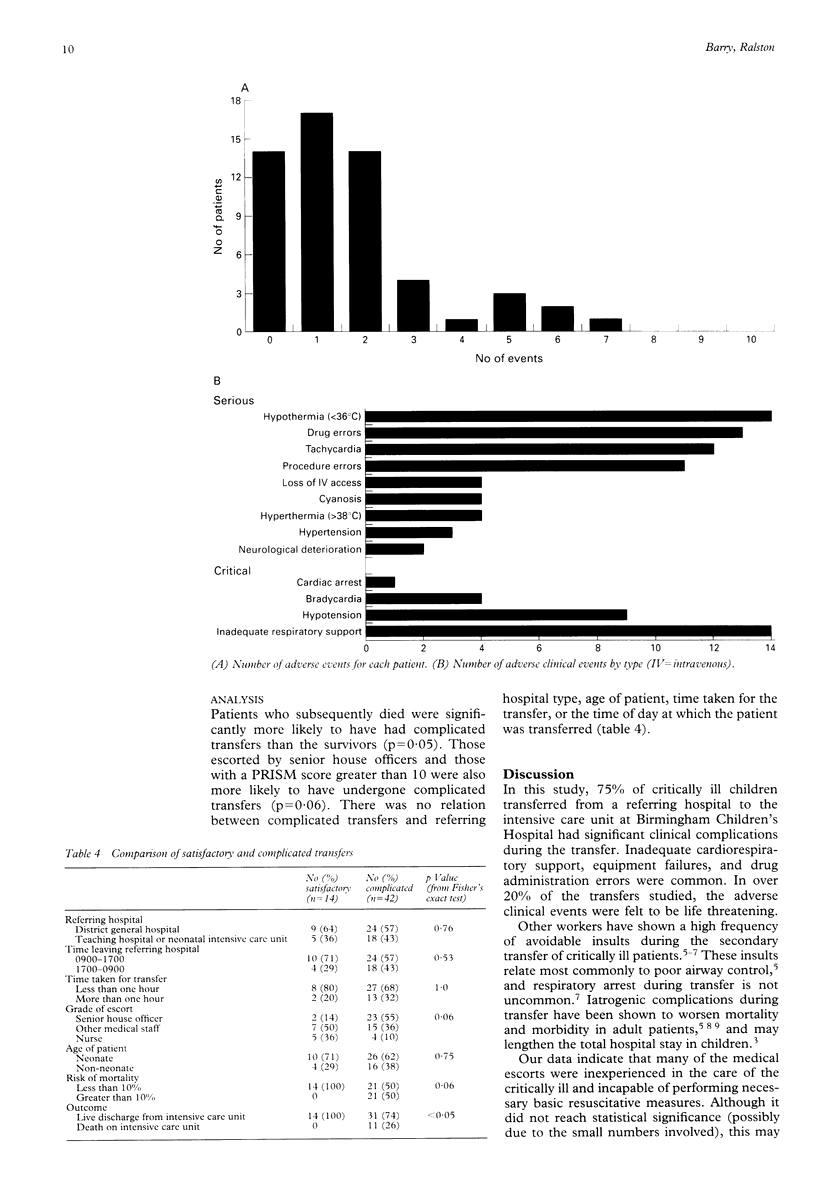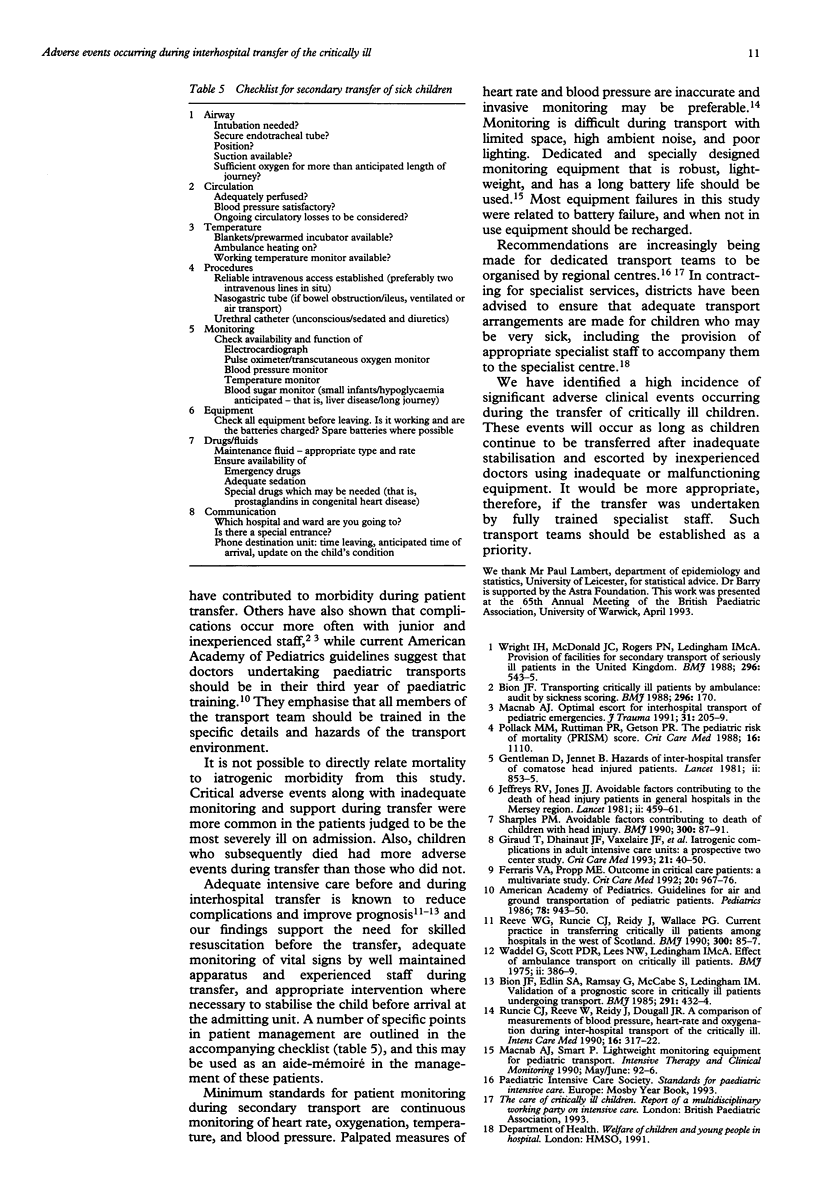Abstract
OBJECTIVE--To determine what complications children have during interhospital transfer for intensive care, and how often these complications occur. DESIGN--Observational study of all children transferred over a six month period, including interviews with patient escort, patient review, and severity of illness scoring. MAIN OUTCOME MEASURES--Timing and method of transport; complications occurring during transport; the equipment and experience of the escort; patient vital signs and paediatric risk of mortality score on admission; outcome and duration of intensive care. RESULTS--Forty two (75%) of 56 children had adverse clinical events during transport. In 13 the event was life threatening. Inadequate circulatory and ventilatory support, inadequate monitoring, equipment failures, and drug errors were common. Children who subsequently died were more likely to have had complicated transfers than those who survived. CONCLUSIONS--Most children had adverse clinical events during transfer for intensive care. A number are transported by inexperienced staff with inadequate or malfunctioning equipment. Standards for patient management and monitoring during transfer need to be established. To reduce unsatisfactory care during transfer, it is necessary to establish dedicated and specifically trained paediatric transport teams.
Full text
PDF



Selected References
These references are in PubMed. This may not be the complete list of references from this article.
- Bion J. F., Edlin S. A., Ramsay G., McCabe S., Ledingham I. M. Validation of a prognostic score in critically ill patients undergoing transport. Br Med J (Clin Res Ed) 1985 Aug 17;291(6493):432–434. doi: 10.1136/bmj.291.6493.432. [DOI] [PMC free article] [PubMed] [Google Scholar]
- Bion J. F., Wilson I. H., Taylor P. A. Transporting critically ill patients by ambulance: audit by sickness scoring. Br Med J (Clin Res Ed) 1988 Jan 16;296(6616):170–170. doi: 10.1136/bmj.296.6616.170. [DOI] [PMC free article] [PubMed] [Google Scholar]
- Ferraris V. A., Propp M. E. Outcome in critical care patients: a multivariate study. Crit Care Med. 1992 Jul;20(7):967–976. doi: 10.1097/00003246-199207000-00012. [DOI] [PubMed] [Google Scholar]
- Gentleman D., Jennett B. Hazards of inter-hospital transfer of comatose head-injured patients. Lancet. 1981 Oct 17;2(8251):853–854. doi: 10.1016/s0140-6736(81)91115-6. [DOI] [PubMed] [Google Scholar]
- Giraud T., Dhainaut J. F., Vaxelaire J. F., Joseph T., Journois D., Bleichner G., Sollet J. P., Chevret S., Monsallier J. F. Iatrogenic complications in adult intensive care units: a prospective two-center study. Crit Care Med. 1993 Jan;21(1):40–51. doi: 10.1097/00003246-199301000-00011. [DOI] [PubMed] [Google Scholar]
- Jeffreys R. V., Jones J. J. Avoidable factors contributing to the death of head injury patients in general hospitals in Mersey Region. Lancet. 1981 Aug 29;2(8244):459–461. doi: 10.1016/s0140-6736(81)90786-8. [DOI] [PubMed] [Google Scholar]
- Macnab A. J. Optimal escort for interhospital transport of pediatric emergencies. J Trauma. 1991 Feb;31(2):205–209. [PubMed] [Google Scholar]
- Pollack M. M., Ruttimann U. E., Getson P. R. Pediatric risk of mortality (PRISM) score. Crit Care Med. 1988 Nov;16(11):1110–1116. doi: 10.1097/00003246-198811000-00006. [DOI] [PubMed] [Google Scholar]
- Reeve W. G., Runcie C. J., Reidy J., Wallace P. G. Current practice in transferring critically ill patients among hospitals in the west of Scotland. BMJ. 1990 Jan 13;300(6717):85–87. doi: 10.1136/bmj.300.6717.85. [DOI] [PMC free article] [PubMed] [Google Scholar]
- Runcie C. J., Reeve W., Reidy J., Dougall J. R. A comparison of measurements of blood pressure, heart-rate and oxygenation during inter-hospital transport of the critically ill. Intensive Care Med. 1990;16(5):317–322. doi: 10.1007/BF01706357. [DOI] [PubMed] [Google Scholar]
- Sharples P. M., Storey A., Aynsley-Green A., Eyre J. A. Avoidable factors contributing to death of children with head injury. BMJ. 1990 Jan 13;300(6717):87–91. doi: 10.1136/bmj.300.6717.87. [DOI] [PMC free article] [PubMed] [Google Scholar]
- Waddell G., Scott P. D., Lees N. W., Ledingham I. M. Effects of ambulance transport in critically ill patients. Br Med J. 1975 Feb 15;1(5954):386–389. doi: 10.1136/bmj.1.5954.386. [DOI] [PMC free article] [PubMed] [Google Scholar]
- Wright I. H., McDonald J. C., Rogers P. N., Ledingham I. M. Provision of facilities for secondary transport of seriously ill patients in the United Kingdom. Br Med J (Clin Res Ed) 1988 Feb 20;296(6621):543–545. doi: 10.1136/bmj.296.6621.543. [DOI] [PMC free article] [PubMed] [Google Scholar]


